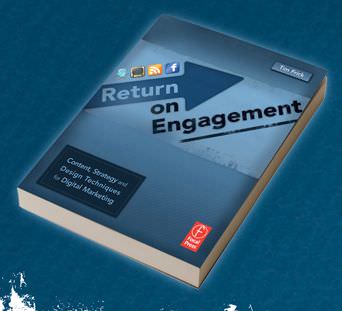10 Tips from Tim Frick for Increasing Online Engagement
These tips will make a world difference in the level of engagement.
By Garin Kilpatrick, Contributing Blogger
Blog: Innovative Digital Marketing
My friend Tim Frick has recently published a great book about online engagement called: Return on Engagement.
I can’t wait to get my copy of Return on Engagement because what I have read of Tim’s book has been highly informative and useful.
Surely you’ve heard of ROI before, but what about ROE? ROE stands for Return on Engagement and that is exactly what Tim’s book is about.
Below are ten tips from Return on Engagement: Content, Strategy and Design Techniques for Digital Marketing to help you build credibility and ultimately foster engagement with customers, connections, community members, and so on.
Fostering online engagement that yields tangible results can be as simple as starting a conversation on someone’s blog or as complex as building and promoting a web application.
All the elements that make up your digital footprint–your website, social networking profiles, shared videos, blog feeds, email marketing campaigns, tweets, and so on–should work in tandem with one another to present a consistent brand image and build engagement with people in your network.
If the goal is to remain relevant in an online world where buying power and the ability to make or break brands resides in the hands of users, one does so by consistently providing content that people need and connecting with them in as personal a manner as possible.
1. Keyword Tip
A combination of broad term (e.g. ‘MP3 Player’) and long tail (e.g. ‘iPod Touch 3G’) keywords and phrases peppered throughout your written content can help search engines better understand your content and serve it up in search results.
Just remember not to overdo it. Keyword density over 8 to 10% of total word count may not only penalize your pages with search engines, but could come off sounding unnatural to readers as well.
[pullquote]Knowing where your audience is and the dynamics for interacting with them across multiple platforms will make a world of difference in their level of engagement.[/pullquote]
2. Design Tip
Reading gravity is the natural pattern our eye takes when viewing or reading a page, typically top left to bottom right (a concept also known as The Gutenberg Rule).
Design your pages with this in mind, putting items with strong brand identity such as logos and important content headers at top left and calls-to-action at bottom right.
3. Content Tip
Using a content management system (CMS) will not only help simplify the process of making site updates, but since regular content updates tend to incite search engine crawls, it could help your site’s ranking as well.
Plus, people are infinitely more likely to return to a website that they know is regularly updated versus one that is static. Drupal, WordPress, Expression Engine, Pixelsilk, Plone and Joomla are just a few of many options available.
//
//
4. Blog Tip
Comments spam is one of a blogger’s biggest nightmares. Using plug-ins such as Disqus, WP Spam Free, Captcha and Akismet on your blog can stop spammers in their tracks and help entry comments serve their intended purpose of exchanging ideas and connecting people.
5. Syndication Tip
If your site has large amounts of video content, Google will let you submit a Media RSS (mRSS) feed as a video sitemap. An mRSS feed has RSS 2.0 features plus the addition of media-specific metadata that helps search engines better categorize your media content and serve it up in more relevant results pages, leading to a better experience for users trying to find specific information.
































Share the post "10 Tips from Tim Frick for Increasing Online Engagement"